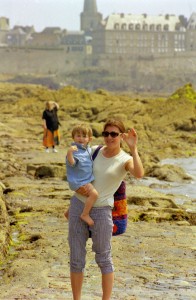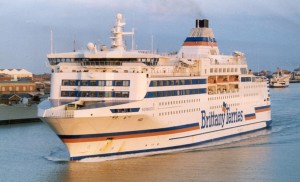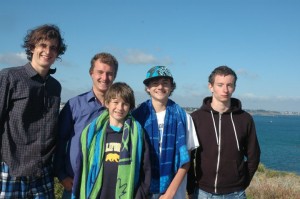St Malo was our first family holiday town.

Here’s St Malo, courtesy of a blog on the 2009 Tour de France on the web. It is not always as sunny, and the tide is not always as high, but you get a feel for what is so special.
It’s an extraordinary walled city on the Northern Brittany coast, less than two hours by car from La Grée, and on the way by car from La Grée to Marlow, from Grand-père to Grandma. If your geographic memories include the English Channel between France and England, it’s still there! Brittany Ferries runs a car ferry from St Malo to Portsmouth and back, once a day during the summer, which was our preferred route from La Grée to Marlow. All very convenient.
But even if it had not been convenient, its amazing seashore and city walls would have seduced us, not forgetting the Hotel de France et de Chateaubriand, with its view of the sea over those walls. The St Malo shoreline is just fabulous, with warm, sandy beaches nestling at the foot of the city walls. There are rocky islands which become part of the shore at low tide, and rocks to scramble on all over the place.
I visited the city regularly before Marie-Hélène and I got together, and liked it in the grey and damp fall and winter as much as during warmer times. Wind and rain on the ramparts, with the grey waves rolling in below you, feels entirely normal there.
Here’s a piece of the French-language description of the town on the original version of this web site, dating from the early 2000s: “St Malo est une ville extraordinaire, reconstruite ‘intra muros’ après les bombardements des alliés sur un île de granite au nord de la Bretagne, pas loin de la Brocéliande.
That translates roughly to: St Malo is an extraordinary city, rebuilt inside its walls after the Allied bombardments on a granite island in the north of Brittany, not far from Brocéliande.
Nous y avons passé trois vacances splendides, grace au beau temps et à cette mer de rêve. Une partie de la splendeur réside dans les ramparts qui encerclent la ville et que vous pouvez deviner au milieu de cette image.”
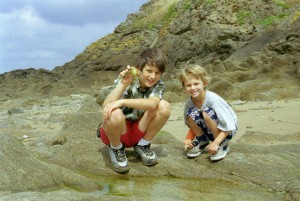
Heaven for small boys is finding a crab in a tide pool! Tom holds it up to the camera, and Charlie shares the joy. This was during our 2001 summer vacation.
The rough translation continues: “We spent three wonderful vacations here, thanks to the beautiful weather and that sea of dreams. A portion of its splendor resides in the ramparts which encircle the city and which you can glimpse in that picture (the one with Marie-Hélène and Alex in, above.)”
The notable event built into that picturesque summary was the bombardment of the city by the Allies during the Second World War. The German occupiers used the Breton ports as bases for attack, like the U-boat port in Brest, to the west, and for defense. Reasonably enough, the ports became targets for Allied air raids (that’s us, people, principally US and UK), and much of the city inside the walls, called “intra muros” locally, was more or less flattened. I have photos bought locally of how the city looked after one of the most powerful bombardments: very traumatic scenes.
Fortunately, it was rebuilt as far as possible in character, using local stone and tracking the buildings as they were before the war. The island that the city is built on is granite, and the stone of the buildings is granite. You can walk along the whole city wall, all around the old city, from the Brittany Ferries port past the causeway heading inland and along the long sea-front beaches.
There was something for all of us in St Malo, which explains why we kept and keep going back, even after we moved to California.
One of the somethings for the children was the amazing natural salt-water swimming pool built on the beach. Its retaining walls are about midway vertically between a normal high and low tide. That means that it captures and circulates the water with each tide, and remains inviting and as safe as the sea can be.

Here is Tom, half way down from the same five meter board as Nick in the above photo. If you look closely, you can see Nick clambering out of the water.
When the tide is high, the five meter stone diving board sticks its solitary neck out of the water, tempting the adventurous.
That would exclude me. I confess that I was not able to jump off the five meter board the one time I tried, although I did manage a couple of jumps from the three-meter. It’s hard to hold your head up with your children after they watch you chicken out of a five-meter jump!
To take the photos above left, I was standing on the pool wall at a relatively low tide, roughly where Nick and Tom are standing in the photo above right. (Here’s a link to Tom in almost the same place: Tom)
The beach itself was home to one of our boys’ major projects.
It was during the summer vacation of 1999, when Daphné and Alban were with their father, that Nick organized a serious sandcastle building project. Well, it was more of a sand wall.
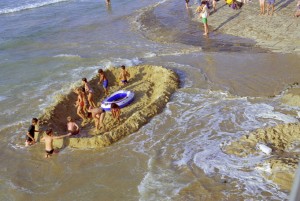
Boys still being boys: note the reinforcements now within the walls! I think that we had pulled Charlie and Alex up the ramp as soon as the sea started swirling around the chateau.
Every day, the tide comes in to cover the top of the beach in the photo above right, and the waves at high tide break on the brick ramp visible at the bottom right of that photo. The four boys, Charlie and Alex included, decided that they were going to build a sea wall that would stop this inevitable tide. If you hear echoes of King Canute here, there are some similarities, but these were small boys rather than a king. Also, I think that they realized that ultimately the wall would not stop the rising tide. The fun, and it was serious fun, was in trying to make it do so for as long as possible!
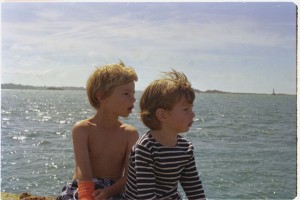
Back again during the summer of 2001. Alex is now three, and Charlie six. This was taken at low tide on the ocean side of one of the small islands around the city. We had walked out on a long causeway that was again underwater after we walked back to shore and the tide came back in.
The photo above left shows you how much they succeeded. Hours of digging went into building up those walls before the sea even approached them. In consequence, the tide was almost high, with the waves already lapping around the ramp in the upper part of the photo, when the walls were finally breached. Before the end of this heroic little island, Nick and Tom had thrown their own bodies into the first breaches in the sandy walls. That didn’t block the waves for very long, of course, but it looked pretty heroic to me.
The project was lots of fun for them, and even for the watching parents.
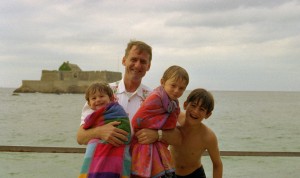
It was a bit brisk some of the time in July 2001. This was at the end of the day, with one of those inhabited islands behind us.
The extraordinary shore at St Malo includes three or four tidal islands, one or two of which are inhabited. As the tide rises, if you are exploring one of these islands, you need to make your way back to the mainland before the tide gets too high. Tourists regularly get caught out on one of them for several cold hours until the tide goes out again. I once saw a group of young people living in or visiting a home on one of the inhabited islands returning home after a day on the mainland, and only just making it across and back to the island as the tide rose, holding their affairs, handbags and sandals and the like, over their heads as the water flowed around their chests. It is a large vertical tide every day.
* * *
I mentioned that the Brittany Ferries cross-channel ferry leaves from St Malo for the seven-hour trip to Portsmouth in England. When Grandma and my Great Aunt Alice were still alive (the latter lived just outside Portsmouth), we took that ferry regularly. Even living in California, some of us manage to take it every couple of years.
Before we left France, we typically took our minivan, a Ford Aerostar that I had imported as a used car from California, on the ferry, so that we would have a big enough car in England. The photo above right shows us driving on to the Normandie, one of the company’s ferries, in late 1996. Taking a page out for the Disney book, Brittany Ferries takes a photo of each car driving on to each ferry. Charlie is on his mother’s lap, and Nick grabbed the armrest between the parents for the picture. Daphné, Tom and Alban are in the first row of seats in the back.
Here’s the Normandie herself, in a photo taken by Brittany Ferries on the way into Portsmouth Harbour. She was a pleasure to travel on. We even managed a souvenir trip without a car from Portsmouth to St Malo during our 2001 summer vacation, and I made the same crossing again during the summer of 2004.
For a little variety, Charlie, Alex and I took the Brittany Ferries from Roscoff (further west in Brittany) to Plymouth (further west in England) during the summer of 2007. Marie-Hélène dropped the three of us off in Roscoff, and rejoined us in the UK a week later.
* * *
We’re cheating a little bit on the rest of this page.
During the summer of 2010, after the time which is technically the end of this photo journal, Tom escorted Charlie and Alex from their father at Portsmouth in England to their mother in St Malo. The three of them took an overnight Brittany Ferries sailing across the English Channel. After Marie-Hélène picked them up the next morning, she took them all for a brisk early morning swim in that unique swimming pool on the beach.
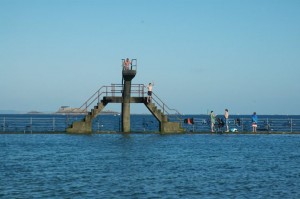
Alban on the five-meter board, Alex jumping from the three, Bertil chatting with Tom and Charlie in his towel.
Alban, who was staying with his mother at La Grée, and their cousin Bertil, Marie-Hélène’s brother’s son, also staying at La Grée at the time, joined in, and they too are included in these two final photos (for now) on our St Malo page.


